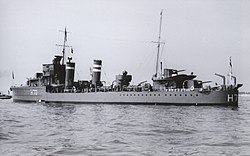HMS Fortune (H70)
|
The Saskatchewan ex Fortune
|
||||||||||||||||||||||||
|
||||||||||||||||||||||||
|
||||||||||||||||||||||||
|
||||||||||||||||||||||||
|
||||||||||||||||||||||||
HMS Fortune (H70) was one of eight F-class destroyers of the British Royal Navy . During the Second World War , the ship was awarded the Battle Honors "Atlantic 1939", "North Sea 1940" and " Malta Convoys 1941-42 ".
On May 31, 1943, the destroyer was taken over by the Royal Canadian Navy and renamed HMCS Saskatchewan . The destroyer was used against submarines in the North Atlantic and in 1944 in the English Channel.
History of the ship
The ship was launched on August 29, 1934 as part of a class of eight destroyers at John Brown & Company in Clydebank . The Fortune entered service on April 27, 1935. She was the 22nd ship in the Royal Navy to receive this name since 1512. Previously, it was worn by the Fairfields Fortune destroyer of the Acasta class from 1912 to 1916, which was honored in the First World War for its service in the sea battle on the Skagerrak , in which it was sunk by German ships of the line.
Mission history
Together with her sister ships, Fortune first formed the 6th, later the 8th destroyer flotilla, which was assigned to the Home Fleet .
After the start of the war, the ship remained with the Home Fleet , but was repeatedly used for submarine hunts together with other destroyers . During one of these search trips he succeeded together with HMS Faulknor , HMS Fearless and HMS Forester , on September 20, 1939 , sinking the German submarine U 27 near the Hebrides .
In 1940, the destroyer was then used in the attempted defense against the German landing in Norway ( Enterprise Weser Exercise ) to cover ships of the Home Fleet.
After they had in the meantime led convoys of troops to North and East Africa , the Admiralty assigned HMS Fortune to the newly formed Force H , which was stationed in Gibraltar . In September 1940, the ship took part in the failed attempt to occupy Dakar ( Operation Menace ). In doing so, however, the destroyer managed to sink the French submarine Ajax .
In the following months, the destroyer was repeatedly used with the Force H in the Mediterranean . It served as an escort for aircraft carriers , from which fighter planes were flown attacks against Malta and for convoys , which mostly transported war material for the British troops in North Africa and supplies for Malta. The ship was also used as a fast mine sweeper. On one of these escorts, HMS Fortune was damaged by a bomb during an air raid .
After the repairs were completed in early 1942, the destroyer ran back into the Mediterranean to serve as part of the remote security for other Malta convoys. The ship was subsequently assigned to the British Eastern Fleet in Trincomalee , Ceylon . During the Japanese attack in the Indian Ocean , it was used as cover for Group 2, which consists of the slower units in the fleet.
From the spring of 1942, however , the HMS Fortune served for several months as the escort of Arctic convoys that supplied the Soviet Union with war material. Another mission followed in the Mediterranean as part of the convoy protection as part of Operation Vigorous . From the Mediterranean it went again to the Indian Ocean , where the ship took part in operations around Madagascar .
At the end of May 1943, the destroyer was handed over to the Royal Canadian Navy , which renamed it HMCS Saskatchewan (H70) . It was now used to secure North Atlantic convoys.
In the summer of 1944, the focus of operations was then in the English Channel and the Biscay , where the destroyer hunted German submarines and outpost boats . In the repeated skirmishes, the flotilla to which he belonged succeeded in sinking several outpost boats. However, it was damaged several times in the process. Further escorts to the Atlantic followed until the end of the war.
HMCS Saskatchewan was decommissioned in January 1946 and later scrapped .
literature
- John English: Amazon to Ivanhoe: British Standard Destroyers of the 1930s. World Ship Society, Kendal (1993), ISBN 0-905617-64-9 .
- Michael J. Whitley: Destroyers of World War Two. An international encyclopedia. Arms and Armor Press, London et al. 1988, ISBN 0-85368-910-5 .
